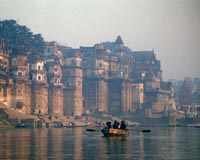| . |  |
. |
Haridwar, India (AFP) Jan 14, 2010 Close to a million Hindu pilgrims bathed in India's holy river Ganges on Thursday in an immense display of colour and devotion at the start of the world's biggest religious festival. Braving chilly weather, hordes of pilgrims rose before sunrise in and around the northern town of Haridwar and walked in darkness to the banks of the river to immerse themselves in the sacred waters. For the rest of the day, crowds of families and couples, wealthy and poor, as well as itinerant "sadhus", or holy men, draped in saffron-coloured robes, took part in the spectacle under the watchful eye of police and paramilitary forces. For Hindu devotees, the three-month Kumbh Mela festival offers them the chance to wash away their sins and break the karmic cycle of life and rebirth. Even in a country where mass events are commonplace, the sheer size of the Kumbh Mela sets it apart. Ram Prakash, a Kumbh Mela organising committee member, told AFP that 831,000 people had bathed by 2:00 local time (0830 GMT) with the figure set to continue rising throughout the day. Millions more are expected to pass through the sprawling festival encampment set up in Haridwar over the next 12 weeks. "Your soul will be cleansed and you will be free from disease if you take such a bath during this period," Sushant Raj, a professional astrologist, said as he emerged from his dip. "The water is cleaner and has more natural power in the early morning," he added. Smaller bathing rituals were held along the entire length of the Ganges. In the eastern state of West Bengal, seven pilgrims, including one child, were crushed to death and 17 were injured during separate harvest festival celebrations that take place across the country to mark the end of winter. The crush happened as hundreds of devotees rushed for places on a ferry to take them to a pilgrimage site on an island where the holy waters of the Ganges flow into the Bay of Bengal. In Haridwar, women clustered on the last of the "ghats" or steps leading down to the river, unravelling their saris and using copper bowls to collect the water and pour it over their heads and torsos. As the day wore on and temperatures rose, many stepped further into the current, immersing their entire bodies. A strong smell of soap mingling with incense and perfume wafted over the river. "The water was really cold," said Bhawna Agri, 14, who travelled with her family from the neighbouring state of Uttar Pradesh to attend her first Kumbh Mela. "I only washed my hair and face and I'm still freezing," she said, shivering on the ghat steps. Foreign tourists and amateur photographers were also out in force, some looking for their own awakening. "It was my dream to come here. I am looking for something more spiritual in my life," 29-year-old machine operator Stefan Martinka from Slovakia told AFP. "I meditated this morning by the river. It was fantastic." The festival commemorates a mythical battle between gods and demons over a pitcher of the nectar of immortality. During the struggle, a few drops of nectar fell in four different places: Allahabad, in the state of Uttar Pradesh, Haridwar in Uttarakhand, Ujjain in Madhya Pradesh and Nasik in Maharashtra. The Kumbh Mela alternates between these four places and takes place every three years. Once every 12 years, an even larger Maha Kumbh Mela is held. The next will be in Allahabad in 2013. The triennial festival also marks the only public gathering of hundreds of Naga sadhus, who otherwise live in relative isolation in mountains, caves and communes in the Himalayas and other regions of India. Naked and generally covered in a layer of grey ash, they are regarded by devotees as earthly representatives of the gods because of their self-sacrifice and denial of the material world. The Nagas, carrying ritual swords and tridents, will lead ceremonies on the most auspicious bathing day of all on April 14 when the Mela draws to a close. Soham Baba, considered the leader of the Nagas, told reporters recently in Kolkata that they planned to use the 2010 Kumbh Mela to highlight the issue of global warming. "Sadhus like us who go up to the higher reaches of the Himalayas to meditate have a clear picture of how bad the situation is," he said. "Pristine lakes and waterfalls that existed till a few years ago have dried up."
Share This Article With Planet Earth
Related Links Water News - Science, Technology and Politics
 Millions brace for holy Ganges festival
Millions brace for holy Ganges festivalHaridwar, India (AFP) Jan 14, 2010 Millions of Hindu pilgrims readied Thursday for a ritual, pre-dawn bath in the waters of the holy Ganges river in northern India as the world's largest religious gathering gets underway. They had come from all over India: In families and couples, wealthy and poor, businessmen and farmhands, and itinerant 'sadhus' or holy men draped in saffron-coloured robes. For Hindu devotees, the three ... read more |
|
| The content herein, unless otherwise known to be public domain, are Copyright 1995-2009 - SpaceDaily. AFP and UPI Wire Stories are copyright Agence France-Presse and United Press International. ESA Portal Reports are copyright European Space Agency. All NASA sourced material is public domain. Additional copyrights may apply in whole or part to other bona fide parties. Advertising does not imply endorsement,agreement or approval of any opinions, statements or information provided by SpaceDaily on any Web page published or hosted by SpaceDaily. Privacy Statement |